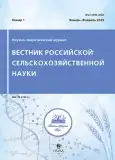Мониторинг эпизоотического состояния пасек Тюменской области и других регионов России
- Авторы: Домацкая Т.Ф.1, Домацкий А.Н.1, Дольникова Т.Ю.1, Зинатуллина З.Я.1, Столбова В.В.1
-
Учреждения:
- Всероссийский научно-исследовательский институт ветеринарной энтомологии и арахнологии-филиал Федерального государственного бюджетного учреждения науки федерального исследовательского центра Тюменского научного центра Сибирского отделения Российской академии наук
- Выпуск: № 1 (2025)
- Страницы: 74-77
- Раздел: Ветеринарная энтомология
- URL: https://journal-vniispk.ru/2500-2082/article/view/287070
- DOI: https://doi.org/10.31857/S2500208225010171
- EDN: https://elibrary.ru/CRVAVJ
- ID: 287070
Цитировать
Аннотация
В статье представлены результаты мониторинга пасек Тюменской области и других регионов России на зараженность пчелиных семей возбудителями инвазий и инфекций. Изучено распространение варроатоза, нозематоза и тропилелапсоза. Исследована 181 проба подмора, живых пчел и расплода от пчелиных семей 21 пасеки в Алтайском крае, Иркутской и Тюменской областях, а также в Республике Дагестан. Работу проводили в соответствии с методическими указаниями по лабораторным исследованиям на нозематоз медоносных пчел, дифференциальной диагностике Nosema apis и Nosema ceranae, изучению средств и приемов борьбы с клещом варроа, диагностике тропилелапсоза, Standard methods for Tropilaelaps. Пчелиные семьи обследованных пасек имеют высокий уровень заражения клещами Varroa destructor (55,5–83,3%), микроспоридией Nosema ceranae (23,1–83,3%), степень инфицированности ноземой составляла от 3,5 до 128 млн спор на пчелу. В патматериале из Республики Дагестан обнаружены клещи Varroa destructor и Tropilaelaps spp., уровень заражения расплодных ячеек – 55,5%, клещи тропилелапс зарегистрированы в 14,5% числа исследуемых ячеек. Также обнаружены личиночные стадии обоих клещей, что свидетельствует об их активном размножении и развитии. Впервые в Тюменской области найдены и идентифицированы клещи Tropilaelaps мersedesae- возбудители тропилелапсоза пчел.
Ключевые слова
Полный текст
Об авторах
Тамара Федоровна Домацкая
Всероссийский научно-исследовательский институт ветеринарной энтомологии и арахнологии-филиал Федерального государственного бюджетного учреждения науки федерального исследовательского центра Тюменского научного центра Сибирского отделения Российской академии наук
Автор, ответственный за переписку.
Email: varroa54@mail.ru
кандидат биологических наук
Россия, г. ТюменьАнатолий Николаевич Домацкий
Всероссийский научно-исследовательский институт ветеринарной энтомологии и арахнологии-филиал Федерального государственного бюджетного учреждения науки федерального исследовательского центра Тюменского научного центра Сибирского отделения Российской академии наук
Email: varroa54@mail.ru
кандидат биологических наук
Россия, г. ТюменьТатьяна Юрьевна Дольникова
Всероссийский научно-исследовательский институт ветеринарной энтомологии и арахнологии-филиал Федерального государственного бюджетного учреждения науки федерального исследовательского центра Тюменского научного центра Сибирского отделения Российской академии наук
Email: varroa54@mail.ru
кандидат химических наук
Россия, г. ТюменьЗимфира Якубовна Зинатуллина
Всероссийский научно-исследовательский институт ветеринарной энтомологии и арахнологии-филиал Федерального государственного бюджетного учреждения науки федерального исследовательского центра Тюменского научного центра Сибирского отделения Российской академии наук
Email: varroa54@mail.ru
кандидат биологических наук
Россия, г. ТюменьВиктория Владимировна Столбова
Всероссийский научно-исследовательский институт ветеринарной энтомологии и арахнологии-филиал Федерального государственного бюджетного учреждения науки федерального исследовательского центра Тюменского научного центра Сибирского отделения Российской академии наук
Email: varroa54@mail.ru
младший научный сотрудник
Россия, г. ТюменьСписок литературы
- Брандорф А.З., Сохликов А.Б. Тропилелапсоз пчел – новая угроза российскому пчеловодству // Российский журнал «Проблемы ветеринарной санитарии, гигиены и экологии». 2023. № 2 (46). С. 217–226. https://doi.org/ 10.36871/vet.san.hyg.ecol.202302014
- Зинатуллина, З.Я., Жигилёва О.Н., Токарев Ю.С. Методические наставления по дифференциальной диагностике Nosema apis и Nosema ceranae у медоносной пчелы (Apis mellifera L.) // Сб. науч. тр. ВНИИВЭА, Тюмень. 2011. Вып. 51. С. 286–300.
- Методические указания по лабораторным исследованиям на нозематоз медоносных пчел / ГУВ МСХ СССР. M. 25.04.1985 г.
- Методические рекомендации по изучению средств и приемов борьбы с клещом варроа / Отделение ветеринарии Россельхозакадемии. M. 08.06. 2020.
- Методические указания по диагностике тропилелапсоза пчел, утверждены Главным управлением ветеринарии Минсельхоза СССР 14.05.1981.
- Anderson D.L., Morgan M.J. Genetic and morphological variation of Bee parasitic Tropilaelaps mites (Acari: Laelapidae): New and re-defined species // Experimental and Applied Acarology. 2007. 43. РР. 1–24.
- Anderson D.L., Roberts John M. K. Standard methods for Tropilaelaps mites Research // Journal of Apicultural Research, 2013. (52:4). РР. 1–16. https://doi.org/10.3896/IBRA.1.52.4.21
- Brandorf A.Z, Ivoilovaa M M., Yanezb O. et al. First report of established mite populations, Tropilaelaps mercedesae in Europe // Journal of Apicultural research. 2024. № 5. PP. 1–3. https://doi.org//10.1080/00218839.2024.2343976
- Joharchi O., Stolbova V. The first report on the ectoparasitic genus Tropilaelaps (Acari: Mesostigmata: Laelapidae) in Russia // Persian J. Acarol. 2023. Vol. 13. No. 3. PP. 513–516. https://doi.org/10.22073/pja.v13i3.85545
Дополнительные файлы










